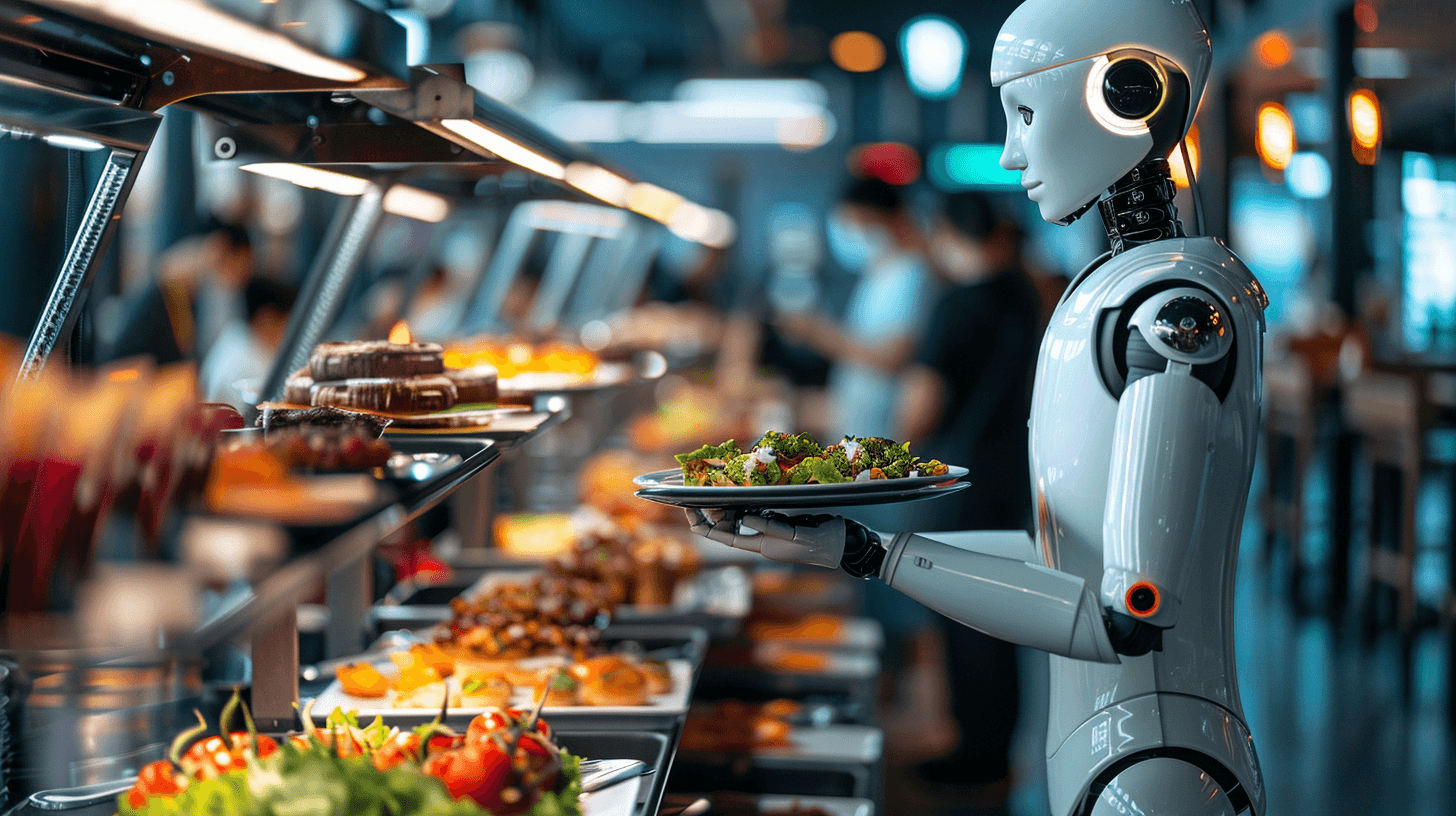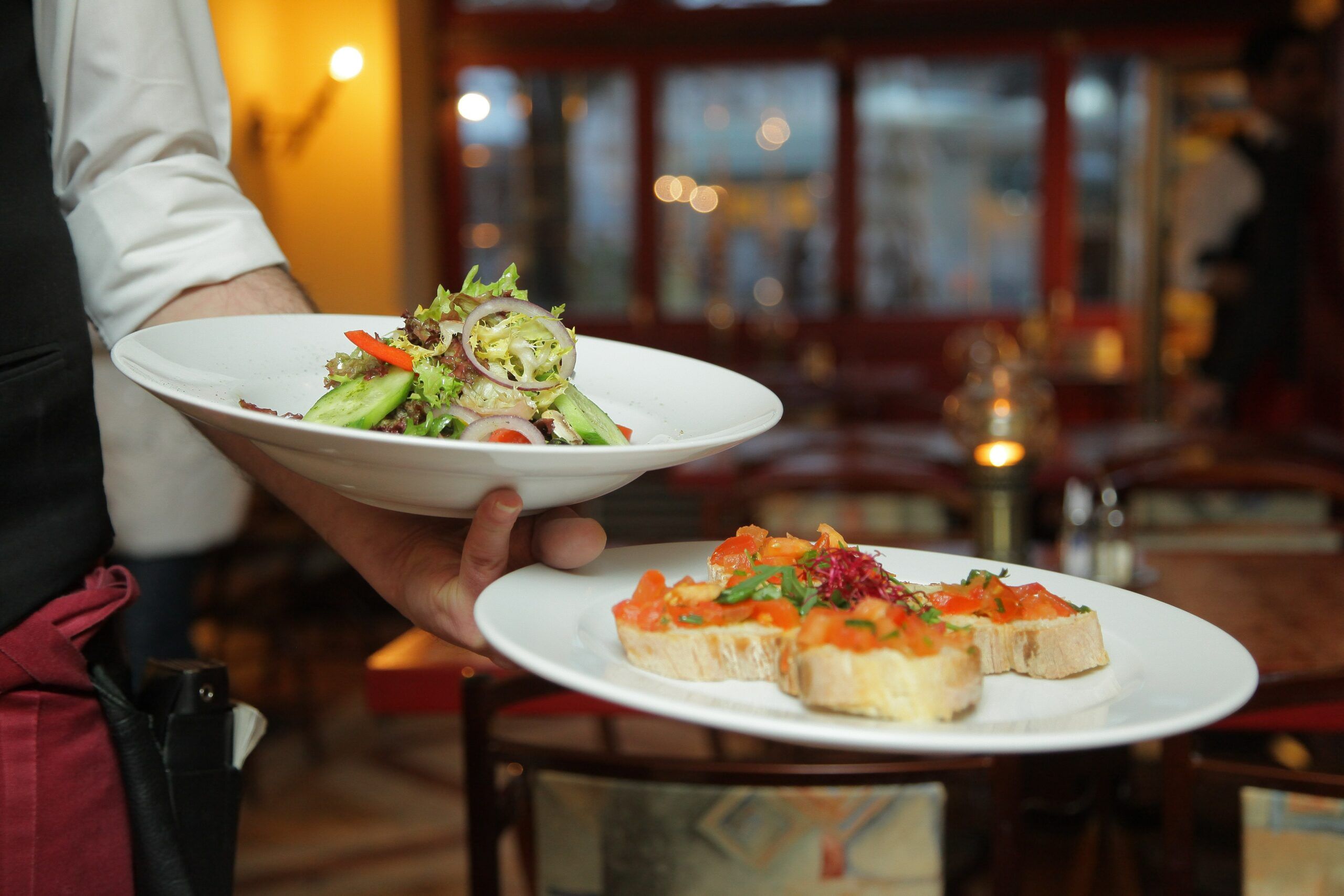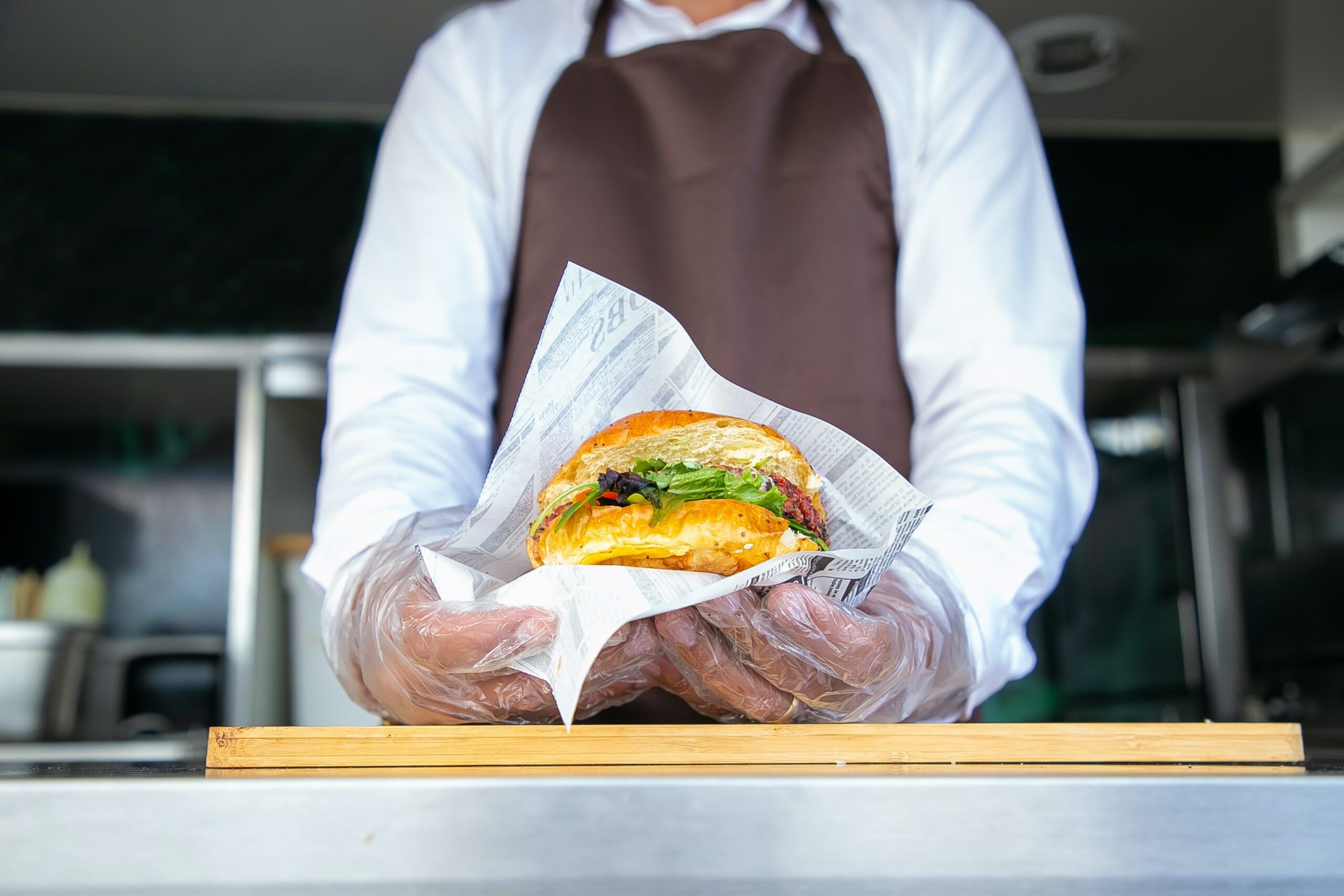- The Meaning of AI in the Food Industry
- Top 10 Benefits of Artificial Intelligence in Restaurant Industry
- Steps into Implementing AI in Your Restaurant
- Harnessing the Power of AI with Orders.co
Technology is changing the way restaurants operate.
Artificial Intelligence is at the forefront of this revolution, bringing many benefits to restaurant owners and customers.
Picture this: restaurants that can predict what customers want before asking run their kitchens more efficiently, providing a personalized dining experience.
It’s not just a dream—it’s happening right now, with AI leading the charge.
Recent stats show that more and more businesses are jumping on the AI bandwagon, with a whopping 270% increase in adoption in just four years.
AI software, such as a restaurant AI website builder, is also pivotal in helping restaurants accelerate their business by creating user-friendly, visually appealing websites to attract and engage customers.
This is just one example of how AI is changing the game in the restaurant industry.
Now, let’s delve deeper into how adopting restaurant AI systems achieves top-notch performance and keeps their customers happy.
The Meaning of AI in the Food Industry
Artificial Intelligence, or AI, is the simulation of human intelligence processes by machines, primarily computer systems.
In simpler terms, it’s about teaching machines (machine learning) to mimic human-like decision-making and problem-solving abilities.
This technology is revolutionizing various industries, including the restaurant sector, by introducing innovative solutions to age-old challenges.
Take McDonald’s, for example.
The global fast-food giant has been at the forefront of AI implementation in the restaurant industry. One prominent example is their use of AI-driven self-service kiosks.
These kiosks have advanced algorithms that analyze customer preferences and order patterns.
When a customer approaches the kiosk, it suggests personalized meal options based on past orders, popular items, and dietary preferences.
Moreover, McDonald’s also utilizes AI-powered predictive analytics to optimize their supply chain management.
By analyzing weather forecasts, historical sales data, and local events, McDonald’s can accurately predict demand for certain menu items at specific locations and adjust their inventory levels accordingly.
This minimizes food wastage and ensures that customers are served fresh and popular items at all times.
In this way, AI is not just a buzzword in the restaurant industry; it’s a tangible tool that enhances efficiency, improves customer satisfaction, and drives profitability.
As more restaurants embrace AI restaurant technology, we expect to see further innovations that revolutionize dining out.
Top 10 Benefits of Artificial Intelligence in Restaurant Industry
AI is reshaping the restaurant industry, offering numerous advantages that streamline restaurant operations, improve customer experiences, and drive profitability.
Here are some key benefits AI brings to a restaurant business:
Efficient Inventory Management
This benefit involves using AI-powered tools to analyze sales data, trends, and other factors to accurately predict inventory needs.
By doing so, restaurants can reduce waste and ensure they always have the right amount of stock on hand.
Companies like Kea Labs provide AI-powered inventory management solutions tailored specifically for restaurants.
Their software analyzes past sales data, seasonal trends, and other factors to accurately predict inventory needs, reducing waste and ensuring optimal stock levels.
Reducing Food Waste
This involves implementing systems that track and analyze food disposal, helping restaurants identify patterns and adjust to minimize waste.
By reducing food waste, restaurants can lower costs and minimize their environmental footprint.
Winnow Solutions offers an AI-powered system that helps restaurants reduce food waste by using AI food tracking tools and analyzing food disposal.
By identifying patterns and suggesting adjustments, Winnow helps establishments like IKEA Food Services significantly reduce waste and associated costs.
Addressing Labor Shortages
This benefit involves deploying automation solutions, such as robotics, to handle repetitive tasks in the kitchen.
By automating these tasks, restaurants can operate efficiently even during labor shortages, ensuring consistency in food preparation.
Flippy, a robotic kitchen assistant developed by Miso Robotics, automates repetitive cooking tasks such as burger flipping.
This technology helps restaurants like CaliBurger handle labor shortages, increase efficiency, and maintain consistency in food preparation.
Automated Guest Feedback Monitoring and Online Review Management
This entails using AI-driven platforms to collect and analyze guest feedback in real-time.
Restaurants like Hummus Republic utilize AI-driven platforms such as Orders.co to collect and analyze guest feedback in real-time.
By automatically aggregating online reviews from multiple sources, Hummus Republic can promptly address concerns and continuously improve the customer experience.
Schedule a FREE Demo with Orders.co
Voice Ordering
This involves implementing voice-activated virtual assistants that allow customers to place orders using natural language commands.
With over 60% of people using voice search nowadays, it’s high time many businesses adopt this AI ordering system.
Domino’s Pizza, for example, introduced Dom, a voice-activated virtual assistant, to streamline the ordering process.
Customers can place orders using natural language commands via the Domino’s app or website, enhancing convenience and reducing friction in the ordering experience.
Personalized Recommendations
This benefit involves leveraging AI to analyze customer preferences and past orders to offer personalized recommendations.
Starbucks leverages AI in its mobile app to offer personalized drink recommendations based on customer preferences and past orders.
By tailoring suggestions to individual tastes, Starbucks enhances customer satisfaction and drives repeat business.
Dynamic Pricing Strategies
This entails using AI algorithms to dynamically adjust pricing based on factors like demand, distance, and time of day.
UberEats uses AI algorithms to dynamically adjust delivery fees based on factors like demand, distance, and time of day.
This flexible pricing strategy helps UberEats optimize revenue while remaining competitive in the food delivery market.
Better Food Safety
This involves using blockchain and AI to track and monitor the supply chain, ensuring the freshness and safety of food products.
IBM’s Food Trust platform utilizes blockchain and AI to enhance food safety and traceability.
By tracking and monitoring the supply chain from farm to table, companies like Walmart ensure the freshness and safety of their food products.
Predictive Maintenance
This benefit involves using AI-powered tools to monitor equipment performance and schedule proactive maintenance.
McDonald’s utilizes AI-powered predictive maintenance tools to monitor restaurant equipment performance.
By analyzing data from kitchen appliances and HVAC systems, McDonald’s can schedule proactive maintenance to prevent costly breakdowns and minimize downtime.
Improved Operations
This entails using AI-powered scheduling software to optimize employee schedules and automate shift planning.
Chili’s Grill & Bar implemented AI-powered scheduling software from 7shifts to optimize employee schedules.
By automating shift planning and labor forecasting, Chili’s improves operational efficiency and employee satisfaction while reducing labor costs.
Steps into Implementing AI in Your Restaurant
Implementing AI in your restaurant can be a game-changer, but it requires very careful planning and execution.
Here are a few steps to successfully integrate AI into your restaurant:
Assess Your Needs
Start by clearly identifying areas of your restaurant operations where AI can make the most impact.
Whether it’s improving ordering processes, optimizing inventory management, or enhancing customer service, pinpointing specific areas for improvement will guide your AI implementation strategy.
Research AI Solutions
Explore the wide range of AI tools and technologies available for restaurants. Consider factors such as scalability, functionality, ease of integration, and affordability.
Look for AI solutions that align with your restaurant’s unique requirements and goals.
Choose the Right AI Partner
Select a reputable AI vendor or partner with expertise in the restaurant industry.
Evaluate their track record, customer reviews, and case studies to ensure they can deliver the solutions and support you need for successful implementation.
Customize Solutions to Fit Your Needs
Work closely with your AI provider to tailor their solutions to your restaurant’s specific workflows and requirements.
Customization ensures that the AI technology seamlessly integrates with your existing systems and processes.
Train Your Staff
Provide comprehensive training to your staff on how to use and interact with AI-powered tools and systems.
Ensure they understand the benefits of AI implementation and how it can enhance their efficiency and productivity in their roles.
Pilot Test
Conduct a pilot test of the AI solutions in a controlled environment before full-scale implementation.
This allows you to identify any issues or areas for improvement and make necessary adjustments before rolling out the technology across your restaurant.
Monitor Performance and Collect Feedback
Continuously monitor the performance of AI systems and gather feedback from staff and customers.
Analyze data and metrics to assess the impact of AI on your restaurant’s operations, customer satisfaction, and bottom line.
Iterate and Improve
Use insights gained from monitoring and feedback to iterate and improve your AI implementation over time.
Be open to refining processes, adjusting configurations, or even exploring new AI solutions to optimize your restaurant’s performance further.
Stay Updated
Keep abreast of advancements in AI technology and trends in the restaurant industry.
Regularly assess your AI strategy and consider upgrades or expansions to leverage the latest innovations and stay ahead of the competition.
Harnessing the Power of AI with Orders.co

Integrating AI in restaurants can significantly improve efficiency, customer satisfaction, and overall success.
Following the steps outlined above, you can successfully implement AI solutions tailored to your restaurant’s needs and goals.
At Orders.co, we offer comprehensive AI-powered solutions to improve your restaurant’s digital presence further and optimize marketing efforts:
- Orders.co introduces an AI-powered website builder tailored for restaurants, enabling swift website creation in 30 seconds or less.
- Seamlessly connect your payment system by contacting us, initiating the launch of your personalized, mobile-optimized ordering platform.
- Our AI technology ensures quick and accurate information by automatically populating menus with the most up-to-date items, descriptions, photos, and modifiers.
- Integration with all third-party systems allows for effortless menu updates across various platforms, ensuring a seamless user experience for your customers.
Book a FREE Demo Call and leverage Orders.co’s AI-driven capabilities, and take your restaurant to new heights!



